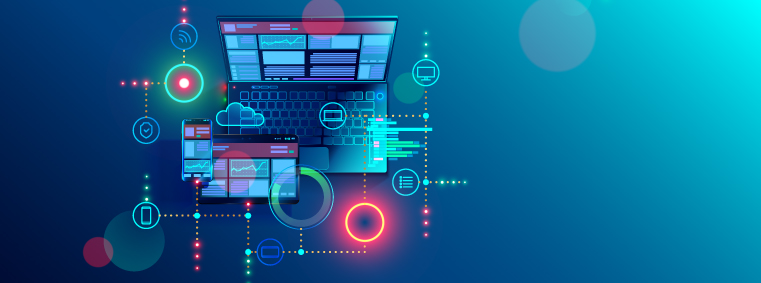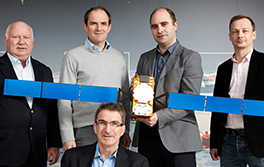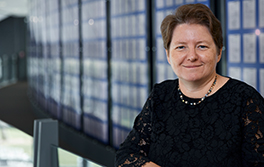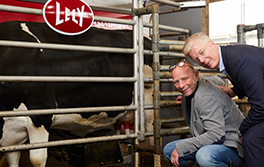Désolé. Actuellement, cette page n'existe pas en français.

The sustained boom in digital technologies in 2020 reflects how frontrunners in major technologies of the Fourth Industrial Revolution (4IR) are shaping an increasingly data-driven economy. Innovation in 5G communication and artificial intelligence (AI) in particular continued to drive patenting activity in the fields of digital communication and computer technology respectively.
After seeing record growth in 2019 and leading the technology field ranking, in 2020 digital communication was narrowly beaten back into second place by medical technology. Together, digital communication and computer technology in third place accounted for over 15% of all European patent applications last year.
As the networks that provided the connectivity for sustaining social and economic activity throughout the pandemic became more crucial to daily life than ever before, patenting activity in digital communication remained robust in 2020. This followed a 20% surge in filings in 2019 as some of the world's first 5G networks went live.
Digital communication comprises the inventions used to transmit digital data: all manner of transmitters and receivers, whether they be smartphones or wireless sensors or even satellites. Sustained levels of innovation in the field, including that required to advance 5G communication, make forecasts for the year 2023 look increasingly realistic, when mobile connections are expected to be around 13 times faster than they are today. The quantum leap in connectivity will boost the Internet of Things (IoT) via which a rapidly growing number of smart connected devices communicate with one another. Countless areas of human activity stand to benefit, ranging from remote surgery to predictive servicing in multiple industry sectors. The enhanced integration of geo-positioning data will advance autonomous vehicle functionalities, while track and trace apps will become faster and more sophisticated so as to meet a variety of needs, including where coronavirus alerts are concerned.
 The international team behind the Europe Union’s Galileo satellite navigation system won the European Inventor Award in 2017.
And in 2020 this system enabled smart phone apps that alert citizens to coronavirus risks, thereby playing a vital role in
reducing transmission. In his recent interview, José Ángel Ávila Rodríguez, one of the team, explains how the apps work.
The international team behind the Europe Union’s Galileo satellite navigation system won the European Inventor Award in 2017.
And in 2020 this system enabled smart phone apps that alert citizens to coronavirus risks, thereby playing a vital role in
reducing transmission. In his recent interview, José Ángel Ávila Rodríguez, one of the team, explains how the apps work.
The field’s top applicant ranking reflects a global three-way race, with European and US leaders interspersed among Asia’s powerhouses. Huawei retained top spot while China maintained a narrow overall lead as the world’s top country of origin (26.5% of total applications). An increase in patent applications from Japan, as NTT Docomo entered the top ten applicants, offset a substantial fall in filings in the field from South Korea.
Within Europe, Sweden comfortably retains its lead as top country of origin (1 275, -0.4% on 2019), with Germany in second place (716, -4.4%). Finland was the growth champion (466 patent applications, +36.7%), and the third largest country of origin for digital communication, as an increase in filings from Nokia saw the Finnish multinational enter the top five applicants.
Looking in detail at just a couple of subdomains within digital communications, we can see that European patent applications for telephone and video conferencing systems have been relatively stable over the last decade (between about 120 to 150 each year from 2011 to 2017). The modest drop in recent years may indicate a "maturity" in this technological area and the ease with which many existing video-conferencing systems responded to rising demand in 2020 shows how well-established the technology has become. We wait to see if increased teleworking leads to a resurgence in innovation in such systems in the coming years. Conversely, the technical field of video codecs (used to encode and compress video data for faster streaming) has enjoyed a relentless rise during the last decade, increasing over 15-fold from 2011 to 2020, with more than 1 000 European patent applications last year.
 Video compression technologies have helped make the spike in videoconferencing manageable, as the pandemic forced people worldwide
to work, learn and even receive new telemedicine services at home, not to mention rely increasingly on streaming services
for entertainment. Marta Karczewicz, who was nominated for the European Inventor Award in 2019, has spent much of her career
in this area of digital technology, developing the so-called “codecs” for the requisite level of data compression that enables
video streaming. The Polish software engineer is Vice President of Technology at Qualcomm and named as inventor on over 130
granted European patents. In July 2020 her latest project was completed: the Versatile Video Coding (VVC) standard, which
increases video streaming efficiency by up to 40%.
Video compression technologies have helped make the spike in videoconferencing manageable, as the pandemic forced people worldwide
to work, learn and even receive new telemedicine services at home, not to mention rely increasingly on streaming services
for entertainment. Marta Karczewicz, who was nominated for the European Inventor Award in 2019, has spent much of her career
in this area of digital technology, developing the so-called “codecs” for the requisite level of data compression that enables
video streaming. The Polish software engineer is Vice President of Technology at Qualcomm and named as inventor on over 130
granted European patents. In July 2020 her latest project was completed: the Versatile Video Coding (VVC) standard, which
increases video streaming efficiency by up to 40%.
Computer technology remains the nerve centre for the automation of countless business processes, innovation in AI and the IoT expansion that is expected to connect as many as 29 billion smart devices by 2023. Many of these devices will be able to process data in real time. As such, computer technology lies at the intersection of telecommunications and computers, and includes innovative hardware and memory, as well as novel forms of data handling and processing.
Innovation in the field continued to thrive in 2020 as patent applications increased by almost 2%, after having surged by 10% in 2019. The latest modest increase conceals contrasting trends, with zero growth from Japan in 2020, and rises of less than 1% each for the US and Europe, offset by substantial growth in patent applications from China (+7.0%) and South Korea (+9.2%). Samsung rose two places to top the applicant ranking, filing more than its US competitors, including Google's parent company Alphabet, which led the previous year. Huawei maintains its position in fifth place.
The top ten applicants are completed by three Japanese and two European companies. Fujitsu displaces Apple from the top ten. And despite decreases in filing volumes from both Siemens and Royal Philips in 2020, these companies' rankings also reflect Germany's leading position (1 093 patent applications, -2.7%) in the field among EPO member states, and the Netherlands' prominence too (385, +0.3%). The country is not far behind France (606, +2.9%) and the UK (458, -0.2%) in second and third place respectively within Europe.
However, the US is still the world's leading country of origin by far for patent applications in the field. This reflects US applicants' strength in core software technology (e.g. operating systems, databases, cloud computing), core AI (e.g. neural networks, deep learning, rule-based systems), 3D systems and the healthcare sector.
Turning to headline trends within the field as a whole, annual European patent applications in AI have grown tenfold in the last decade, to over 800 filings in 2020. The exciting new field of quantum computing is at barely one tenth of this volume, but the first patent applications only started arriving at the EPO in the last four years. And the rate of growth, albeit from low levels, is close to 300%.
 Milking robots that benefit the wellbeing of both cows and dairy farmers collect data via a scannable collar for each cow
and use a robotic arm with sensors that detect teats. Developed by European Inventor Award finalists Alexander van der Lely
and Karel van den Berg, the robots are one product among many that reflect Europe's strength in smart agriculture. This is
in turn testament to the diversity of the broader 4IR innovation ecosystem across EPO member states. Meanwhile, the number
of patent applications filed at the EPO for “smart agriculture” inventions has doubled over the last decade, and for the last
three years exceeded 250 per year. As farmers begin to test multispectral crop analysis with drones, driverless tractors and
AI powered pest detection, the Fourth Industrial Revolution is set to drive an agricultural one.
Milking robots that benefit the wellbeing of both cows and dairy farmers collect data via a scannable collar for each cow
and use a robotic arm with sensors that detect teats. Developed by European Inventor Award finalists Alexander van der Lely
and Karel van den Berg, the robots are one product among many that reflect Europe's strength in smart agriculture. This is
in turn testament to the diversity of the broader 4IR innovation ecosystem across EPO member states. Meanwhile, the number
of patent applications filed at the EPO for “smart agriculture” inventions has doubled over the last decade, and for the last
three years exceeded 250 per year. As farmers begin to test multispectral crop analysis with drones, driverless tractors and
AI powered pest detection, the Fourth Industrial Revolution is set to drive an agricultural one.
The rise of smart technologies extends to all major economic areas of activity. Think of the development of the smart home and smart cities for sustainable urban living or the modernisation of communication networks and the entire infrastructure of the rapidly growing global data sphere to reduce carbon footprints; or enabling the kind of smart irrigation that can help advance food security the world over. Innovation in safer and more sustainable e-mobility is increasingly driven by smart technologies too, as are all manner of consumer goods from smart watches and wearables to sport devices, toys and textiles. The increasing number of smart robots in factories, construction sites and hospitals are also helping to improve our wellbeing. Smart implants constitute one area among many delivering the latest advances in preventative, predictive and personalised healthcare.
Just over five years after the United Nations adopted its 17 sustainable development goals (SDGs) in September 2015, it comes as no surprise that many of the leading applicants at the EPO have firmly integrated their approaches to innovation in digital technologies with the pursuit of SDGs. The link between growth and sustainability is clear. 4IR technologies are expected to contribute over two trillion euros to the EU economy alone by the end of the decade, by which time the SDGs are intended to be fully implemented. And the EPO is well-prepared to protect and foster the latest innovation in 4IR technologies as they become increasingly central to tackling the greatest challenges currently faced by humankind. Last year, in addition to the publication of our study on patents and the Fourth Industrial Revolution, in which you can learn more about the trends, technologies and case studies mentioned here, we also held our second major conference on the patenting of AI inventions.
Now that the global pandemic has accelerated the digital transformation, connectivity, new forms of knowledge sharing and keeping pace with technological convergence are more essential than ever. The rise of digital technologies is set to continue as the planet becomes smarter in the pursuit of a safer and more sustainable future.